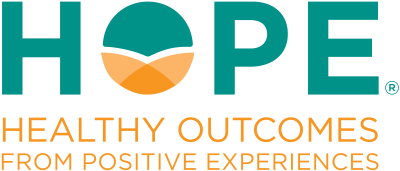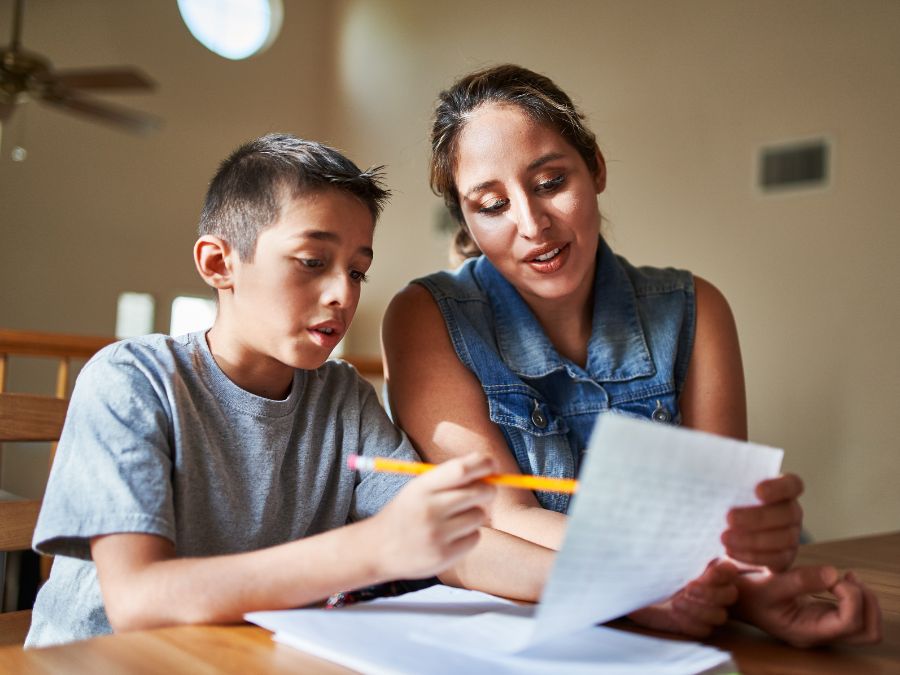
We hosted the best HOPE Summit yet!
The HOPE National Resource Center concluded its Fifth Annual HOPE Summit last week, bringing together over 470 attendees from the United States, Canada, Chile, the United Kingdom, India, Australia, Ireland, and Mexico. We thank everyone for their support and enthusiasm to make this year’s Summit the best yet!
Like previous years, the latest Summit equipped professionals with the tools, knowledge, and inspiration to create positive change in their organizations and communities using the Healthy Outcomes from Positive Experiences (HOPE) framework. HOPE centers around the promotion of the key types of positive childhood experiences (PCEs), which we call the Four Building Blocks of HOPE, that have the biggest impact on children’s health and well-being later into adulthood.
This year’s theme – Shaping the Future: A Framework for Every Sector – focused on applying the HOPE framework in five child- and family-serving sectors: healthcare, education, child welfare, substance misuse prevention, and the HOPE Impact.
Those who registered for the Summit can still access the platform to watch recordings of the keynote addresses, workshops, and the closing panel session.
Keynote highlights
Creating your own recipe for HOPE
The Summit opened with a keynote address from HOPE Director Robert Sege, MD, PhD, who reflected on the journey of the HOPE National Resource Center.
It began five years ago, looking at science and understanding that PCEs are important for child development, especially when children have faced adversity. From research, we created the HOPE framework, informed by other evidence-based programs and our partners with lived experiences. And today, we are advancing the practice of HOPE to not only individual professionals and organizations but also communities across multiple families and organizations.
Our latest video, voiced by Eliza Loren Purdue, described the HOPE movement today.
Dr. Sege shared a four-ingredient recipe for HOPE and encouraged everyone to make their own HOPE creation, taking inspiration from these ingredients:
- Research and science: Our research with our partners proves the transformative power of PCEs. For instance, the 2015 Wisconsin BRFSS data showed PCEs protect adult mental health, and the 2021 Tennessee BRFSS data found that higher PCEs protect overall health, such as lower rates of heart disease and depression.
- Programs that work: We continue to develop a growing number of resources and trainings where individual professionals, organizations, and communities can learn more about PCEs and apply the HOPE framework in their practice.
- Lived Experiences: We regularly engage with our partners who share their own lived experiences. This further informs us of how HOPE can be practiced in unique communities, helping us create new resources and trainings based on these lived experiences.
- Dedication and wisdom: We have seen professionals and organizations use HOPE to create positive change. In Michigan, the Great Start Collaborative used HOPE to improve the retention of teachers. In Massachusetts, Tufts Medicine Pediatric Primary Care in Boston adopted HOPE to improve their physical spaces to make them more welcoming for families.
‘What actually counts? What really matters?’
Day two of the Summit began with a keynote address from Junlei Li, PhD, Co-Chair of the Human Development and Education Program, and Saul Zaentz Senior Lecturer in Early Childhood Education at the Harvard Graduate School of Education. Much of his work focuses on what he calls the “helping professionals.” They are people who support and empower children, families, and communities.
Finding and growing HOPE with the simple, ordinary things every day was the central theme of Dr. Li’s talk. He outlined three reasons for HOPE:
- Ordinary interactions, extraordinary care
- Ordinary resources, extraordinary quality
- Ordinary practices, extraordinary quality
Dr. Li shared two videos that resonated deeply with the audience.
The first video showed ordinary interactions creating extraordinary care. Ms. Paula works as a crossing guard at a four-way stop in Pittsburgh, PA. Every day, she talks, jokes, and compliments the school children, all while guiding them through the crosswalks.
Dr. Li asked the audience – what difference did Ms. Paula make? The chat was filled with admiration and applause for the helping professional. She affirms the children for who they are. She pays attention to them by remembering past conversations.
The second video was on ordinary resources creating extraordinary quality. Dr. Li has visited a rural farming village in China that became a foster care community for children with developmental and physical disabilities. Despite low educational credentials and low resources, the farmers started a school.
The video from his first visit shows a teacher and students laughing and smiling as they blow a tissue attached to a pen. Even with limited resources, everyone in the video exemplified resourcefulness, creating high-quality moments through connection, inclusivity, and an opportunity to grow.
“We have to answer the questions: what actually counts? What really matters?” said Dr. Li.
Workshop highlights
The Summit featured 15 incredible workshops led by experts in the fields of child welfare, education, healthcare, substance misuse prevention, and the HOPE Impact. Each workshop presenter shared how they practice the HOPE framework in their work with children and families to create positive change.
Exciting workshops include Royale Lockhart’s “Every Child Needs A Hero: Early Childhood Education Providers!” on education and Meredith Velasquez, LCSW, LAC, ACS’s “Implementing HOPE framework in Screening and Assessment for Successful Outcomes with Families” on child welfare.
Look in a mirror and meet a hero – You!
In her workshop, Royale Lockhart recognized every attendee for what they were already doing as early childhood educators – being an “everyday hero.”
“You are the people who show up before the sun rises, who comfort tears, who celebrate milestones, and who notice the quiet victories others might miss,” she said.
Lockhart framed both the research and practice of the HOPE framework in the context of education. She emphasized how educators are a bridge between early learning and lifelong resilience.
This is your power, she said. These powers are magnified by the Four Building Blocks of HOPE that all children need to thrive. The Building Blocks show up in the classroom, school routines, and educator-student relationships every single day.
“Big or small, it [PCEs] matters,” Lockhart concluded. “Every hero starts with HOPE – and that hero is you.”
Shifting from deficit- to asset-based practices in assessment centers
Assessment centers provide assessments for youth who have been arrested by law enforcement. Their purpose is to avoid unnecessary detention. This is a step in the right direction, says presenter Meredith Velasquez, but more can be done.
These centers often operate in a deficit-based model. This leads to problems such as families being referred to an expert to be “fixed” and an overreliance on assessment tools that box families into labels.
The HOPE framework, Valasquez argues, helps shift from a deficit- to asset-based practice.
“We want to build what we already have in our community…to create long-lasting effects for youth and families, because we are a part of that too. We are healing our communities together. If they are a part of our community, we have to do it with them.”
Using the HOPE framework and other models such as Youth Thriving and Healing Centered Engagement, the Juvenile Assessment Center, where Velasquez works, is improving its assessment process. This includes using tools like the Four Building Blocks of HOPE as a talking point rather than a rating scale, not equating ACEs with risk, and supporting interactions where youth and families have a voice.
Panel discussion highlights
Video: virtual road trip across the United States
The Summit event finale began with an inspiring video, narrated by Dr. Sege and Amanda Winn, HOPE Director of Training and Technical Assistance, highlighting the work of HOPE Champions around the U.S. The following Champions shared stories of how they are practicing the HOPE framework in their communities to create positive change for the children they serve:
- Carlos Blake, Tampa Housing Authority (Tampa, FL)
- Samanthia Moore Valentine, (Augusta, GA)
- Meghan Bates, Centerstone (Pulaski, TN)
- Hilary Marine, Pathwaves Partnership (Spring Lake, MI)
- Ashley Stallings, Upper Valley Child Advocacy Center (Rigby, ID)
- Rumyana Kudeva and Jennifer Hansen, Spokane Regional Health District (Spokane, WA)
- Jade Aldrich, First 5 Mendocino (Ukiah, CA)
- Natasha Paddock, O.P.E. Family Support Center (Walnut Creek, CA)
- LaTysa Flowers-Jackson, YMCA of San Diego County (San Diego, CA)
Q&A: HOPE leadership answers questions about all things PCEs
After the video, Dr. Sege and Amanda Winn engaged with the audience live to answer their questions about the HOPE framework and how they can promote more PCEs in their work, including:
How can you learn more about practicing the HOPE framework?
Dr. Sege kicked off the Q&A session with his gratitude towards the HOPE Champions featured in the video and wondered how each Champion learned about practicing HOPE. Amanda Winn outlined five progressive levels of HOPE learning that anyone can start:
- HOPE resources: Access our free 50+ resources. Many are available for download.
- Online course hub: Enroll in our free, self-paced online courses, including an introduction to HOPE and sector-specific focuses such as child welfare and home visiting. Many of our courses offer CME and CMU credits.
- HOPE Train the Facilitator Certification: Learn how to deliver HOPE workshops in your community as a certified HOPE Facilitator.
- HOPE Champion Certification: Develop your in-depth technical assistance skills to guide organizations through implementing HOPE as a certified HOPE Champion.
- HOPE-Informed Organizational Certification: As a certified HOPE Champion, work with your (or any) organization to provide technical assistance or help implement HOPE to become a certified HOPE-Informed organization.
How can I focus on the positive more often?
One attendee asked for advice on how they can focus on the positive more often.
Type 1 vs. Type 2 thinking immediately came to mind for Amanda Winn. Type 1 thinking is fast, intuitive, and unconscious, based on our past experiences. Type 2 thinking is slow, calculating, conscious thought involving novel concepts and ways of thinking.
“For many of us, going to the positive is not Type 1 thinking,” explained Winn. With Type 2 thinking, you can slow yourself down and choose to focus on the positive.
Winn reflected on a story about a home visitor struggling with Type 2 thinking. What was her solution? She placed a sticky note reminder on her car dashboard to start with the positive. Before she left the car, she touched the sticky note. This visual cue and physical habit helped ground her to embrace the positive.
You can also incorporate more positive thinking structurally in your work. Winn recommends HOPE resources, like the HOPE and Strengthening Families-Informed coaching guide and HOPE-Informed supervision and leadership handout, where organizational supervisors can review and update their forms, policies, and programming to be more strengths-based.
“Sometimes, just wanting to be strengths-based isn’t enough,” said Winn. “We have to formalize it.”
How do I start conversations about HOPE?
Another question centered on starting the initial conversations about HOPE.
Type 2 thinking returned as the key advice. “We have to think about intentionally starting those conversations [about HOPE],” said Dr. Sege.
As a direct service provider, for instance, you can first engage with children by asking them fun “icebreaker” questions, like about their best friend (i.e. asking about their relationships), favorite activities during the weekend (engagement), and places that make them happy (environment), that center on the Four Building Blocks of HOPE. Encourage them to draw their responses with coloring pencils or crayons. Or reenact their experiences as a skit. This is a great way to help children and their parents feel heard and seen, and ultimately, more willing to hear how HOPE can help them.
“The bottom line is curiosity,” he said. “How did that person get to be here today? What helped them? What [Building Block of] relationships? What environment? What’s going on that made them have the desire to get better?”
When you start with supportive questions and allow children and families to talk about themselves, you position yourself as a helpful coach, rather than a deficit-seeking judge.
Join the HOPE movement today!
Learn more about the HOPE framework and how it can positively impact the children and families you serve. Take our free online courses and downloadable resources that will help you expand your practice. We are excited for you to join us in the movement to spread HOPE!
The HOPE National Resource Center thanks our sponsor, Point32Health, keynote speakers, and workshop presenters for supporting the Fifth Annual HOPE Summit. We are proud to work with We & Goliath as the event manager and producer.


